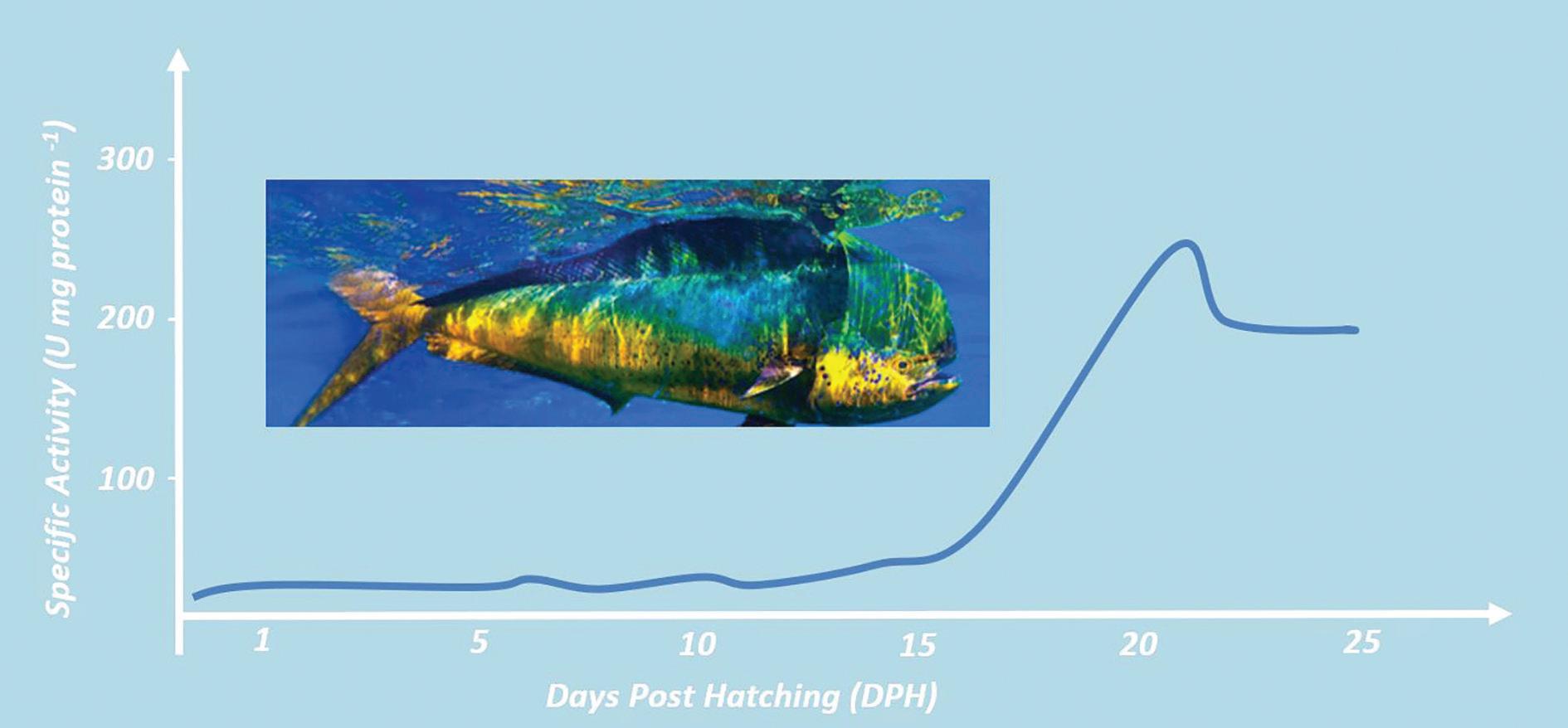
7 minute read
Efficiency in tropical marine finfish hatcheries: Enhancing new species development and boosting fully commercial operations for incremental survival and superior fry quality
Marcell Boaventura, Filipe Pereira and Cuong Huynh Tran, ADM animal nutrition
Figure 1. Acid digestive protease (Pepsin) activity during early ontogeny of Mahi-mahi (Coryphaena hippurus) (Stieglitz et al., 2020). Mahimahi image courtesy of the University of Miami.
The progress of the global aquaculture industry depends on the availability of quality seeds; in commercial numbers, being able to sustain the increasing demand for high quality seafood. Make no mistake, this is no “light-bulb” moment where it all just came together for many professionals in aquaculture. However, the more we engage with hatcheries around the globe, the more we can see the true value and payback obtained from elevating hatchery standards with practices connected to species and attention to details such as early trophic ontogeny, quality of live preys and early fry behavior. In this article, we will cover a few factors influencing efficiency in some of the best marine finfish hatcheries around the globe, and provide a practical outlook for implementation from a scientific point of view.
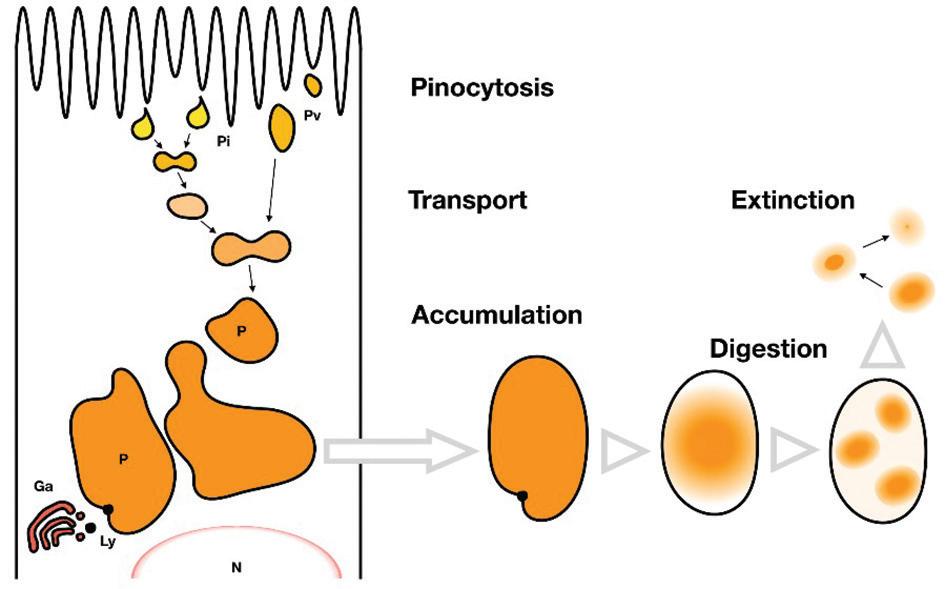
Figure 2. Successive, five stages of protein absorption and intracellular digestion by the hindgut epithelial cells of fish larvae. Organelles include pinocytotic invagination (Pi), pinocytotic vesicles (Pv), protein inclusion bodies (P), Golgi apparatus (Ga), lysosomes (Ly), and nucleus (N) (Govoni et al., 1986).
Some aspects within the trophic ontogeny of marine finfish larvae What has been entirely unambiguous to this point is the fact that species have distinct requirements. However, most species prosper through ontogeny in a similar way, giving managers important cues for advanced technical management. In terms of trophic ontogeny, at the very beginning, the larvae possess a simple and undifferentiated alimentary canal. This primordial structure evolves and by the end of metamorphosis, it comprises a complex functional segmentation, and a digestive architecture is maintained until adult fish. Before the distinct digestive organs appears, most fish larvae still lack digestive enzymes. In practical terms, without digestive enzymes, especially pepsin, proteins cannot be deconstructed into amino acids by the larvae, the “building blocks of life.” So how can we ensure fish larvae are taking in most of the nutrients in feeds during such a critical stage in the hatchery? Ensuring the nutritional quality and cleanliness of live feeds and selecting feeds rich in free-amino acids and small peptides.
What makes a copepod nutritionally superior to a rotifer is the content of total and free amino acids (Dabrowski & Rusiecki, 1983). With the challenges in producing copepods, the commercial focus must be on making other live feeds nutritionally comparable to copepods. The nutritional profile of live feeds can be managed and increasing content of free amino acids is linked to the use of certain algal mediums (Aragão et al., 2004).
Live feeds nutrition and cleanliness The passage of nutrient particles through the digestive tract of a rotifer is fast, especially at tropical temperatures. When microalgae are available (e.g. when rotifers are placed in larval tanks with thick green water), enrichment is eliminated and particles excreted are still rich in absorbable nutrients (Lindemann & Kleinow, 2000). This characteristic can become an advantage if nutrients are incorporated to the rotifer vitellarium. That happens when rotifers are fed certain single cell microalgae.
Rich vitellarium eliminates the dependency on the gut content for larvae nutrition which is usually
Figure 3. Progression of assimilation and intra-cellular digestion into extracellular digestion post-metamorphosis illustrated with Southern bluefin tuna (Thunnus maccoyii) larvae and juveniles.
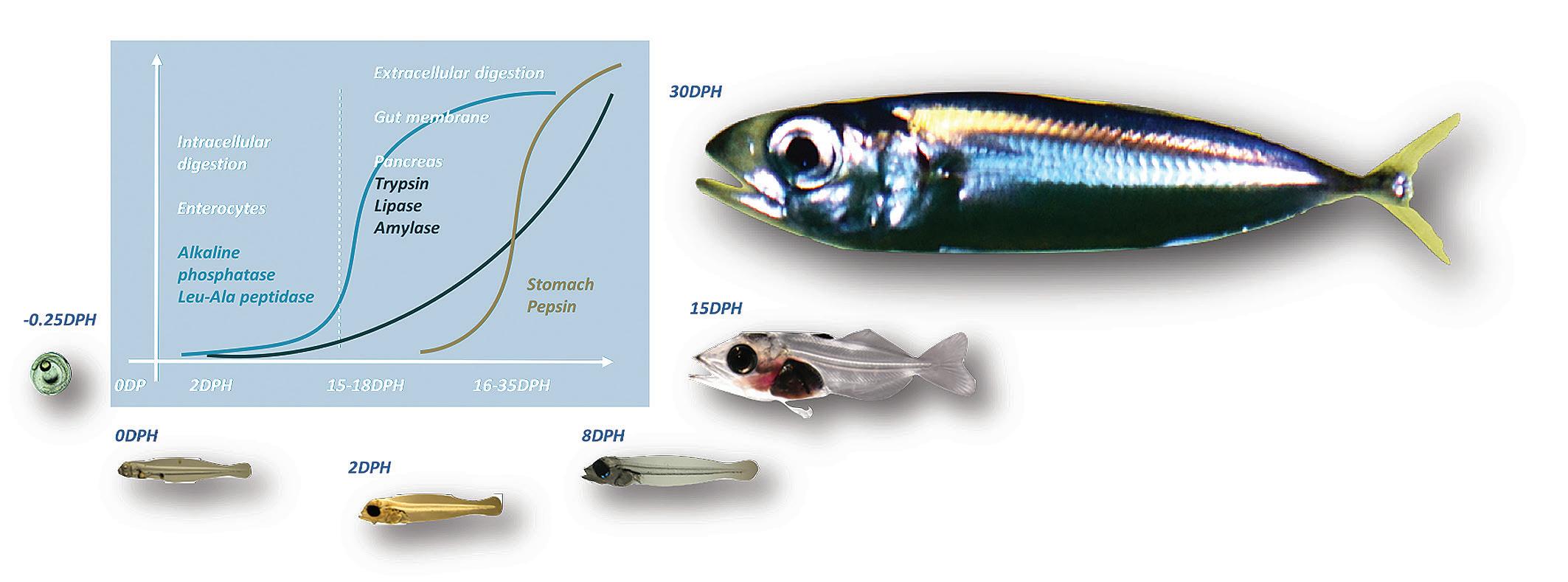
Figure 4. (A) Rotifers simultaneously cultivated and DHA/EPA enriched with ω3 Algae from Bernaqua, (St) Stomach and Germo-Vitellarium. A dry algal medium, based on Chlorella vulgaris, enriched with essential fatty acids. (B) Hydrated ω3 Algae, single cell separation.

contaminated with Vibrio spp. and other undesired microorganisms. The gut content can be substituted by probiotic before feeding the larval tanks. This process, called “bioencapsulation”, allows the engineering of the microbiological profile of rotifers with no loss to its nutritional value. Bioencapsulation can also be applied during Artemia enrichment and has been demonstrated in commercial hatcheries with increments in early survival.
Another factor to control when managing quality in live feeds is the availability in larval rearing tanks. Long exposure of live feed residuals in the larval rearing tanks can become an issue. As filter feeders, live feeds continue to accumulate in their gut system any opportunistic bacteria which are fast growing in the larval rearing tanks. In water, these bacteria are usually harmless to the larvae, but when assimilated by the live feeds, the potential to harm the larvae increases. Fish larvae are non-selective hunters as far as quality and cleanliness, hence when residuals are excessive, increasing a cyclic daily water exchange is usually effective.
Efficiency during co-feeding and weaning Last but not least, we will discuss a final few points. • The efficient introduction of dry feeds, followed by the intensive “training” of fry on diet recognition and feeding. The co-feeding stage is a crucial step for survival and fry quality. During co-feeding,
Figure 5. Feeds produced by different technologies, its appearance on the electronic microscope and its behavior in water. (A) Microparticulate diet. (B) Micro-encapsulated diet, “Caviar” by Bernaqua. (C) The behavior of a micro-particulate diet in water (soaking, leaching and sinking). (D) Behavior of a micro-encapsulated diet in water (clear water as no leaching occurs and the maintenance of particles in suspension).
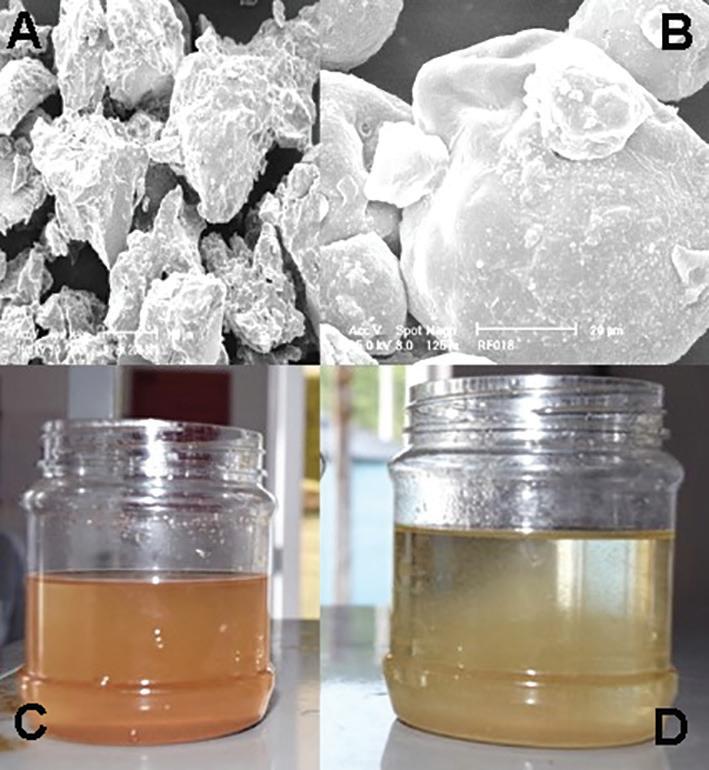
interest to inert feed is only “investigative”, hence frequent exposure of larvae to diets are key. The problem lies in the fact that most cofeeding diets are microparticulate and slow sinking. These diets leach and sink to the bottom,
Figure 7. High quality and colorful Asian seabass (Lates calcarifer) sampled during high density weaning in Cam Ranh, Vietnam. Image courtesy of ADM team Vietnam.
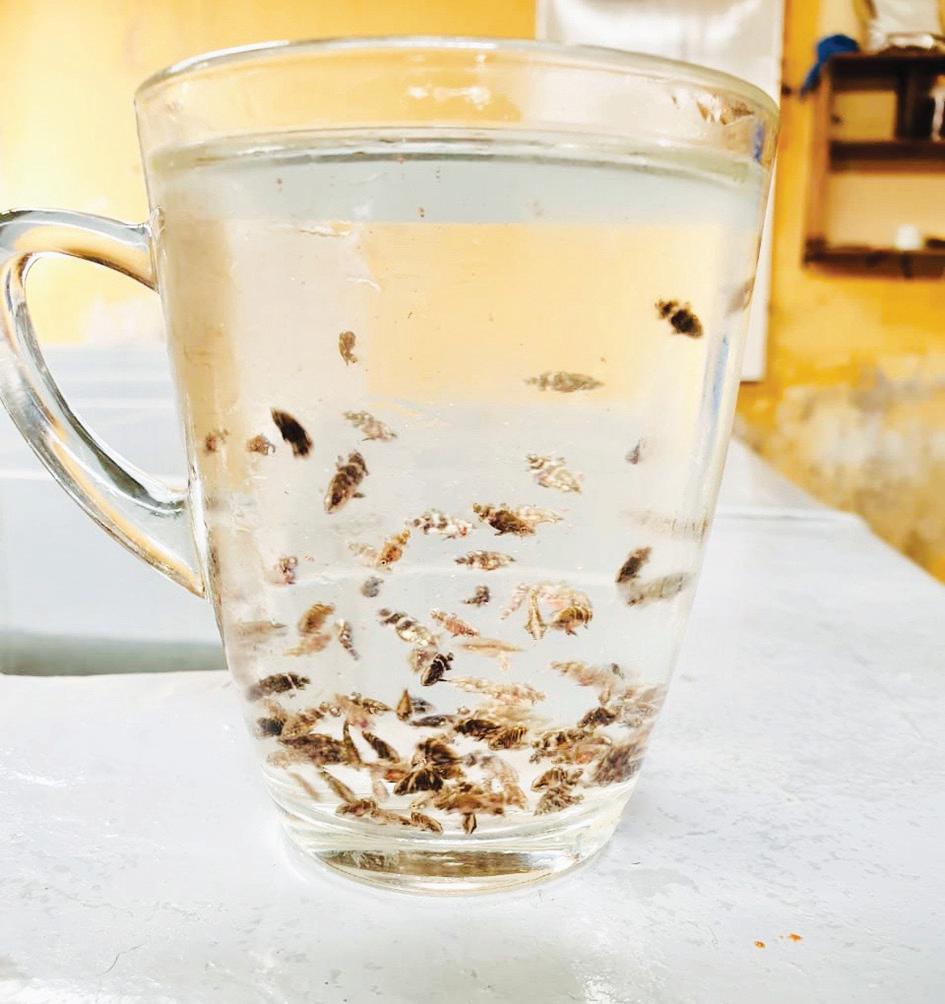
damaging the water quality and increasing bacterial contamination in tanks that contaminates the live feeds. • Micro-encapsulated diets represent an important advantage for fish hatcheries. During the co-feeding stage, micro-encapsulated diets stay in suspension long enough to increase the exposure of larvae to the feed with minimal leaching. Co-feeding ration can be reduced by at least 30% for a positive impact on water cleanliness. • Delaying the introduction of Artemia by 2-3 days. This factor promotes batch homogeneity. When Artemia is offered too early, only a small portion of larvae may feed on Artemia leading to size disparity and very soon increased cannibalism. Delayed offerings of Artemia allow most of the population to feed on Artemia at first introduction. A complete elimination of Artemia has also been reported when quality and cleanliness of rotifers are combined. • During weaning, attentiveness to behavioral cues of each species is pivotal. With higher enzymatic functions after the metamorphosis, hunting and cannibalism peak. In contrast, many species are prompted to “schooling”, an innate reflex observed both in nature and captivity. To the advantage of hatchery managers, schooling promotes imitation making weaning, which basically is training the fry to eat artificial diets, an efficient effort. It is important to note that schooling promotes a cooperative defensive behavior which has been confirmed by a number of fish behaviorists (Palov & Kasumyan, 2000). In commercial hatcheries, we have observed and replicated key triggers for schooling leading to sensible benefits in survival, early weaning and fry quality. In short, those triggers include density, light and hydrodynamics. We also note schooling behavior can be disrupted when fry size within a school differs by more than 50% of the average body length (Shaw, 1962), and the cooperative defensive behavior can’t be promoted at low fry densities. In Asian seabass (Lates calcarifer) for instance, we have experienced improvements in fry survival and robustness when weaning happened under schooling. Fry are crowded with 100-150 fry per liter under certain conditions of tank hydrodynamic, water exchange, light and feeding regime. Schooling and cooperative defensive behavior is triggered along with imitation behavior, which lead to enhanced feeding and mass early weaning at 22-23 DPH.
In conclusion, it is important to reinforce that hatchery efficiency and performance is a multifactorial equation, which changes from species to species and in most cases is also site-specific. We believe that close observation and generous attention to details by competent hatchery managers are a couple of the factors responsible for value creation in hatchery businesses.
References available on request.
More information: Marcell Boaventura Sales Manager APAC Bernaqua, based in Australia E: marcell.boaventura@adm.com
Filipe Pereira Sales Manager EMEA Bernaqua, based in Italy

Cuong Huynh Tran Regional Technical Manager Ocialis, based in Vietnam










